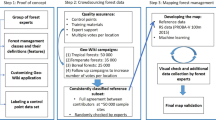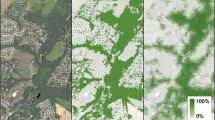Abstract
Many countries undertake a national forest inventory to enable statistically valid monitoring in support of national and international reporting of forest conditions and change. Canada’s National Forest Inventory (NFI) program is designed to operate on a 10-year remeasurement cycle, with an interim report produced at the 5-year mid-point. The NFI is a sample-based inventory, with approximately 18,850 2 ×2-km photo plots across the country, distributed on a 20×20-km grid of sample points; these photo plots are the primary data source for the NFI. Capacity to provide annual monitoring information is required to keep policy and decision makers apprised of current forest conditions. In this study, we implemented a multistage monitoring framework and used a Moderate Resolution Imaging Spectroradiometer (MODIS) change product to successfully identify 78% of the changes in forest cover area that were captured with a Landsat change detection approach. Of the NFI photo plots that were identified by both the Landsat and MODIS approaches as having changes in forest cover, the proportion of change area within the plots was similar (R 2 = 0.78). Approximately 70% of the Landsat-derived change events occupied less than 40% of a single MODIS pixel, and more than 90% of the change events of this size were successfully detected with the MODIS product. Finally, MODIS estimates of the proportion of forest cover change at the NFI photo plot level were comparable to change estimates for the ecoregions as a whole (R 2 = 0.95). High-temporal, low-spatial resolution imagery such as MODIS, in combination with other remotely sensed data sources, can provide information on disturbance events within a national forest inventory remeasurement cycle, thereby satisfying the interim information needs of policy and decision makers as well as the requirements of national and international reporting commitments.
Article PDF
Similar content being viewed by others
Avoid common mistakes on your manuscript.
References
Ahl, D. E., Gower, S. T., Burrows, S. N., Shabanov, N. V., Myneni, R. B., & Knyazikhin, Y. (2006). Monitoring spring canopy phenology of a deciduous broadleaf forest using MODIS. Remote Sensing of Environment, 104, 88–95.
Anaya, J. A., Chuvieco, E., & Palacios-Orueta, A. (2009). Aboveground biomass assessment in Colombia: A remote sensing approach. Forest Ecology and Management, 257, 1237–1246.
Baccini, A., Laporte, N., Goetz, S. J., Sun, M., & Dong, H. (2008). A first map of tropical Africa’s above-ground biomass derived from satellite imagery. Environmental Research Letters, 3. doi:10.1088/1748–9326/3/4/045011.
Bormann, F. H., & Likens, G. E. (1979). Pattern and process in a forested ecosystems. New York: Springer-Verlag.
Bucha, T., & Stibig, H.-J. (2008). Analysis of MODIS imagery for detection of clear cuts in the boreal forest in north-west Russa. Remote Sensing of Environment, 112, 2416–2429.
Carroll, M., Townshend, J. R. G., Hansen, M. C., DiMiceli, C., Sohlberg, R., & Wurster, K. (in press). Vegetative cover conversion and vegetation continuous fields. In B. Ramachandran, C. Justice, & M. Abrams (Eds.), Land remote sensing and global environmental change: NASA’s EOS and the science of ASTER and MODIS. New York: Springer.
Cihlar, J. (2000). Land cover mapping of large areas from satellites: Status and research priorities. International Journal of Remote Sensing, 21, 1093–1114.
Coops, N. C., Ferster, C. J., Waring, R. H., & Nightingale, J. (2009). Comparison of three models for predicting gross primary production across and within forested ecoregions in the contiguous United States. Remote Sensing of Environment, 113, 680–690.
Crist, E. P., & Cicone, R. C. (1984). Application of the tasseled cap concept to simulated Thematic Mapper data. Photogrammetric Engineering and Remote Sensing, 50, 343–352.
Cuevas-Gonzàlez, M., Gerard, F., Balzter, H., & Riano, D. (2009). Analysis of vegetation dynamics after wildfire disturbance in Siberian boreal forests using remote sensing. Global Change Biology, 15, 561–577.
deGroot, W. J., Landry, R., Kurz, W. A., Anderson, K. R., Englefield, P., Fraser, R. H., et al. (2007). Estimating direct carbon emissions from Canadian wildland fires. International Journal of Wildland Fire, 16, 593–606.
Ecological Stratification Working Group (1996). A national ecological framework for Canada. Agriculture and Agri-Food Canada, Research Branch, Centre for Land and Biological Resources Research, and Environment Canada, State of the Environment Directorate, Ottawa. http://sis.agr.gc.ca/cansis/publications/ecostrat/cad_report.pdf. Accessed 25 May 2009.
Englefield, P., Lee, B. S., Fraser, R. H., Landry, R., Hall, R. J., Lynham, T. J., et al. (2004). Applying geographic information systems and remote sensing to forest fire monitoring, mapping and modelling in Canada. In R. T. Engstrom, K. E. M. Galley, & W. J. de Groot (Eds.), Proceedings of the 22nd tall timbers fire ecology conference: Fire in temperate, Boreal and Montane ecosystems (pp. 240–245). Tallahassee: Tall Timbers Research Station.
Gao, F., Masek, J., Schwaller, M., & Hall, F. (2006). On the blending of the Landsat and MODIS surface reflectance: Predicting daily Landsat surface reflectance. Transactions on Geoscience and Remote Sensing, 44, 2207–2218.
Gillis, M. D. (2001). Canada’s National Forest Inventory (Responding to current information needs). Environmental Monitoring and Assessment, 67, 121–129.
Gillis, M. D., Omule, A. Y., & Brierley, T. (2005). Monitoning Canada’s forests: The national forest inventory. The Forestry Chronicle, 81, 214–221.
Hais, M., Jonášová, M., Langhammer, J., & Kučera, T. (2009). Comparison of two types of forest disturbance using multitemporal Landsat TM/ETM + imagery and field vegetation data. Remote Sensing of Environment, 113, 835–845.
Han, T., Wulder, M. A., White, J. C., Coops, N. C., Alvarez, M. F., & Butson, C. (2007). An efficient protocol to process Landsat images for change detection with tasselled cap transformation. IEEE Geoscience and Remote Sensing Letters, 4, 147–151.
Hansen, M. C., DeFries, R. S., Townshend, J. R. G., Sohlberg, R., Carroll, M., & Dimiceli, C. (2002). Towards an operational MODIS continuous field of percent tree cover algorithm: Examples using AVHRR and MODIS data. Remote Sensing of Environment, 83, 303–319.
Hansen, M. C., DeFries, R. S., Townshend, J. R. G., Carroll, M., Dimiceli, C., & Sohlberg, R. A. (2003). Global percent tree cover at a spatial resolution of 500 meters: First results of the MODIS Vegetation Continuous Fields Algorithm. Earth Interactions, 7, 1–15.
Hansen, M. C., Roy, D. P., Lindquist, E., Adusei, B., Justice, C. O., & Alstatt, A. (2008a). A method for integrating MODIS and Landsat data for systematic monitoring of forest cover and change in the Congo Basin. Remote Sensing of Environment, 112, 2495–2513.
Hansen, M. C., Shimabukuro, Y. E., Potapov, P., & Pittman, K. (2008b). Comparing annual MODIS and PRODES froest cover change data for advancing monitoring of Brazilian forest cover. Remote Sensing of Environment, 112, 3784–3793.
Hawbaker, T. J., Radeloff, V. C., Syphard, A. D., Zhu, Z. L., & Stewart, S. I. (2008). Detection rates of the MODIS active fire product. Remote Sensing of Environment, 112, 2656–2664.
Hilker, T., Wulder, M. A., Coops, N. C., Linke, J., McDermid, G., Masek, J. G., et al. (2009). A new data fusion model for high spatial- and temporal-resolution mapping of forest disturbance based on Landsat and MODIS. Remote Sensing of Environment, 113, 1613–1627.
Jin, S. M., & Sader, S. A. (2005). MODIS time-series imagery for forest disturbance detection and quantification of patch size effects. Remote Sensing of Environment, 99, 462–470.
Ju, J., & Roy, D. P. (2007). The availability of cloud-free Landsat ETM + data over the conterminous United States and globally. Remote Sensing of Environment, 112, 1196–1211.
Justice, C. O., Townshend, J. R. G., Vermote, E. F., Masuoka, E., Wolfe, R. E., Saleous, N., et al. (2002). An overview of MODIS land data processing and product status. Remote Sensing of Environment, 83, 3–15.
Kim, S. (2008). Onset date of forest canopy detected from MODIS leaf area index. Journal of Ecology and Field Biology, 31, 153–159.
Lee, B. S., Alexander, M. E., Hawkes, B. C., Lynham, T. J., Stocks, B. J., & Englefield, P. (2002). Information systems in support of wildand fire management decision making in Canada. Computers and Electronics in Agriculture, 37, 185–198.
Lunetta, R. S., Knight, J. F., Ediriwickrema, J., Lyon, G. L., & Worthy, L. D. (2006). Land-cover change detection using multi-temporal MODIS NDVI data. Remote Sensing of Environment, 105, 142–154.
Metsaranta, J. M., & Lieffers, V. J. (2009). Using dendrochronology to obtain annual data for modelling stand development: A supplement to permanent sample plots. Forestry, 82, 163–173.
Morton, D. C., DeFries, R. S., Shimabukuro, Y. E., Anderson, L. O., Espírito-Santo, F. D. B., Hansen, M., et al. (2005). Rapid assessment of annual deforestation in the Brazilian Amazon using MODIS data. Earth Interactions, 9, 1–22.
Peckham, S. D., Ahl, D. E., Serbin, S. P., & Gower, S. T. (2008). Fire-induced changes in green-up and leaf maturity of the Canadian boreal forest. Remote Sensing of Environment, 112, 3594–3603.
Peng, C. (2000). Understanding the role of forest simulation models in sustainable forest management. Environmental Impact Assessment Review, 20, 481–501.
Potapov, P., Hansen, M. C., Stehman, S. V., Loveland, T. R., & Pittman, K. (2008). Combining MODIS and Landsat imagery to estimate and map boreal forest cover loss. Remote Sensing of Environment, 112, 3708–3719.
Power, K., & Gillis, M. (2006). Canada’s Forest Inventory 2001. Information Report BC-X-408 (140 p.). Natural Resources Canada, Canadian Forest Service, Victoria.
Skakun, R. S., Wulder, M. A., & Franklin, S. E. (2003). Sensitivity of the thematic mapper enhanced wetness difference index to detect mountain pine beetle red-attack damage. Remote Sensing of Environment, 86, 433–443.
Stocks, B. J., Mason, J. A., Todd, J. B., Bosch, E. M., Wotton, B. M., Amiro, B. D., et al. (2003). Large forest fires in Canada, 1959–1997. Journal of Geophysical Research, 108. doi:10.1029/2001JD000484.
Wang, F., & Xu, X. J. (2009). Comparison of remote sensing change detection techniques for assessing hurricane damage to forests. Environmental Monitoring and Assessment. doi:10.1007/s10661-009-0798-8.
Wu, J. B., Xiao, X. M., Guan, D. X., Shi, T. T., Jin, C. J., & Han, S. J. (2009). Estimating the gross primary production of an old-growth temperate mixed forest using eddy covariance and remote sensing. International Journal of Remote Sensing, 30, 463–479.
Wulder, M. A., Kurz, W. A., & Gillis, M. (2004). National level forest monitoring and modeling in Canada. Progress in Planning, 61, 365–381.
Wulder, M. A., White, J. C., Bentz, B., Alvarez, M. F., & Coops, N. C. (2006). Estimating the probability of mountain pine beetle red-attack damage. Remote Sensing of Environment, 101, 150–166.
Zhan, X., Sohlberg, R. A., Townshend, J. R. G., DiMiceli, C., Carroll, M. L., Eastman, J. C., et al. (2002). Detection of land cover changes using MODIS 250 m data. Remote Sensing of Environment, 83, 336–350.
Author information
Authors and Affiliations
Corresponding author
Rights and permissions
Open Access This is an open access article distributed under the terms of the Creative Commons Attribution Noncommercial License (https://creativecommons.org/licenses/by-nc/2.0), which permits any noncommercial use, distribution, and reproduction in any medium, provided the original author(s) and source are credited.
About this article
Cite this article
Wulder, M.A., White, J.C., Gillis, M.D. et al. Multiscale satellite and spatial information and analysis framework in support of a large-area forest monitoring and inventory update. Environ Monit Assess 170, 417–433 (2010). https://doi.org/10.1007/s10661-009-1243-8
Received:
Accepted:
Published:
Issue Date:
DOI: https://doi.org/10.1007/s10661-009-1243-8




